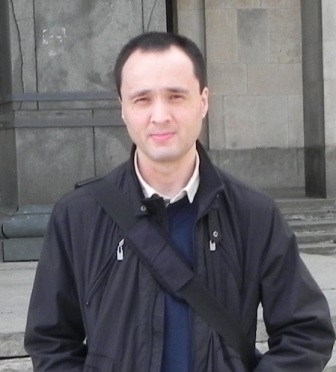

Interview with Tajik scholar Shavkat Kasymov
By Maneh Hakobyan
-Shavkat, you recently published an article entitled ?The Example of the Armenian Genocide and the Role of the Millet System in Its Execution? in the journal Social Identities. Can you please tell us why you decided to write an article on the Armenian genocide?
I came to know about the awards for the publication of articles on the Armenian genocide through the introductory letter of Dr. Tigran Sarukhanyan. I decided to write this article because I think there is a need to honor the victims of those tragic events, especially now that we are approaching their centennial anniversary in 2015. The Armenian genocide led to the deaths of some 1.500.000 people. I think that once again we need to raise the issue of guilt and responsibility, since according to many analyses, including mine, the Armenian genocide was orchestrated by the government of the Ottoman Empire and aimed at the elimination of the its Christian populations, primarily the Armenians, Greeks, and Assyrians.
-Can you describe the main argument and purpose of your article?
The article engages with two theoretical approaches in the field of genocide studies, and it discusses how one of these approaches is superior to another, particularly through the lens of the case of the Armenian genocide.
One of these approaches suggests that genocide occurs as a result of significant structural changes, such as wars, revolutions, economic and political crises. While it is an important contribution to Genocide Studies, this approach does not reveal the leading driving force behind mass killing. The other approach maintains that mass killing originates in the policies of political elites.
My article suggests that the Armenian genocide was part of the political and strategic goals of the political elites in the Ottoman Empire, who sought to transform the empire into a homogenous nation-state through the deportation and extermination of the Armenian minority as an example of the Final Solution.
The Armenian minority was seen by the Young Turks as an obstacle to the ideology of Pan-Turkism, which eventually led to the creation of modern Turkey. I draw on empirical evidence, secondary sources, and theory to support my argument.
-Could you please tell us whether you are planning to write more articles on this topic in the future, and what do you think are the main problems facing this field of knowledge?
I would like to write more articles on the Armenian genocide in the future, especially when I find credible primary materials and empirical evidence. However, I believe that we have to look at the Armenian genocide not only from an historical perspective, but also from the standpoint of Genocide Studies, in order to bring the analyses to a completely new and higher level, and develop and implement adequate policies that would eliminate the potential for such atrocities occurring again in the future.
Source: Hetq, 03 May 2013
http://hetq.am/arm/news/26127
Read also:
Tashir Charity Foundation opens a new era in front of Armenian Genocide research
TEXT IN ARMENIAN
Հարցազրույց տաջիկ ցեղասպանագետ Շավքաթ Կասիմովի հետ
Զրուցեց Մանե Հակոբյանը
?Շավքաթ, վերջերս Դուք ?Հասարակական ինքնություններ? պարբերականում հրատարակել եք ?Հայոց ցեղասպանության օրինակը և միլլեթի համակարգի դերը դրա իրականացման գործում? հոդվածը։ Կարո՞ղ եք ասել, թե ինչու եք հոդված գրել Հայոց ցեղասպանության մասին:
Այս հոդվածը որոշեցի գրել, քանի որ կարծում էի, որ կարիք կա հարգելու այդ դժբախտ իրադարձությունների զոհերի հիշատակը՝ հաշվի առնելով դրա հարյուրամյա տարելիցը 2015 թվականին: Հայոց ցեղասպանությունը պատճառ հանդիսացավ մեկուկես միլիոն մարդկային զոհերի: Ես կարծում եմ, որ մենք կրկին պետք է բարձրացնենք մեղքի և պատասխանատվության հարցը, քանի որ բազմաթիվ վերլուծությունների հիման վրա, դրանց թվում նաև՝ իմ, Հայոց ցեղասպանությունը Օսմանյան կայսրության նպատակային մտադրությունն էր: Ի թիվս այլ նպատակների՝ այն նպատակ ուներ ոչնչացնել առկա քրիստոնյա ժողովուրդներին, գլխավորապես՝ հայերին, հույներին, ասորիներին:
-Հակիրճ կբացատրե՞ք հոդվածի գլխավոր պնդումները և նպատակը:
Հոդվածն ընդգրկում է ցեղասպանագիտության մեջ առկա երկու տեսական մոտեցումներ և քննարկում է` թե ինչու մեկ տեսակետը ավելի գերակա է մյուսի նկատմամբ՝ հիմք ընդունելով Հայոց ցեղասպանության օրինակը:
Մի տեսակետն առաջարկում է այն դրույթը, համաձայն որի` ցեղասպանությունը արդյունք է նշանակալի համակարգային փոփոխությունների, ինչպիսիք են՝ պատերազմները, հեղափոխությունները, տնտեսական, քաղաքական ճգնաժամերը: Թեև այն կարևոր ներդրում է հանդիսանում ցեղասպանագիտության ոլորտում, այն չի բացահայտում զանգվածային սպանության գլխավոր շարժիչ ուժը: Մյուս տեսակետը ենթադրում է, որ ցեղասպանությունը սկիզբ է առնում իշխող էլիտայի քաղաքականությունից:
Իմ հոդվածն առաջադրում է այն տեսակետը, որ Հայոց ցեղասպանությունը արդյունք էր քաղաքական և ռազմավարական այն նպատակների, որոնցով առաջնորդվում էր օսմանյան քաղաքական վերնախավը՝ դիտելով Օսմանյան կայսրությունը միատար ազգային միավորում ստեղծելու գլխավոր ուղին՝ որպես վերջնական որոշում՝ հայերին բռնագաղթի ենթարկելու և նրանց ոչնչացնելու մեջ:
Հայկական փոքրամասնությունը երիտթուրքերի կողմից դիտարկվեց՝ որպես խոչընդոտ պանթուրքիզմի, այն պանթուրքիզմի, որն ի վերջո հանգեցրեց ժամանակակից Թուրքիայի ստեղծմանը: Իմ փաստարկները հիմնավորելու համար ես հիմք եմ ընդունել էմպիրիկ ապացույցները, երկրորդային աղբյուրները և տեսությունները:
-Արդյոք պլանավորո՞ւմ եք ապագայում գրելու նոր հոդվածներ այս խնդրի վերաբերյալ:
Այո, ցանկություն ունեմ գրելու լրացուցիչ հոդվածներ Հայոց ցեղասպանության վերաբերյալ, հատկապես` երբ կարողանամ գտնել առաջնակարգ սկզբնաղբյուրներ և էմպիրիկ ապացույցներ: Ընդհանրապես, կարծում եմ, որ չպետք է ցեղասպանության խնդրին անդրադառնալ միայն պատմագիտական տեսանկյունից, այլև՝ ցեղասպանագիտության, որպեսզի հնարավոր լինի վերլուծություններն իրականացնել ավելի բարձր մակարդակով։ Գիտության այս ճյուղի հեռահար նպատակը պետք է լինի` մշակել ու ապա իրագործել այնպիսի քաղաքականություն, որը կբացառի ապագայում նմանատիպ վայրագությունների իրականացումը:
